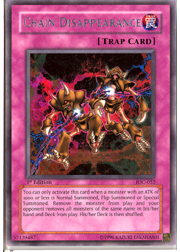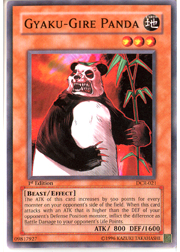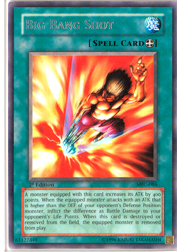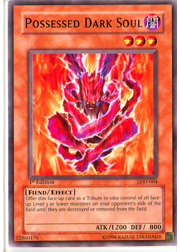I love tech. While the work we do here at Metagame.com towards building teams and individual players is invaluable, sometimes it’s nice to just dive into a big pile of under-appreciated cards. Join me as I explore four of today’s most influential pieces of tech!
 Chain Disappearance: This card saw only a bit of play, but massive success when it was used. It’s likely the best way to stymie Thousand-Eyes Restrict, removing the offending monster from play and often costing the opponent card advantage. Even though the Thousand-Eyes Restrict itself is being pulled from the Fusion deck, you’re making a one-for-one trade if the Thousand-Eyes Restrict is summoned with Metamorphosis and a sheep token. On the other hand, you’re gaining a two-for-one advantage if the opponent attempted to use a newly-set Magician of Faith for Metamorphosis’s tribute. It’s a great bit of tech that easily fits into any side deck strategy.
Chain Disappearance: This card saw only a bit of play, but massive success when it was used. It’s likely the best way to stymie Thousand-Eyes Restrict, removing the offending monster from play and often costing the opponent card advantage. Even though the Thousand-Eyes Restrict itself is being pulled from the Fusion deck, you’re making a one-for-one trade if the Thousand-Eyes Restrict is summoned with Metamorphosis and a sheep token. On the other hand, you’re gaining a two-for-one advantage if the opponent attempted to use a newly-set Magician of Faith for Metamorphosis’s tribute. It’s a great bit of tech that easily fits into any side deck strategy.
And the best part? If you nail a Thousand-Eyes Restrict with Chain Disappearance, the opponent must remove all copies of Thousand-Eyes Restrict from his or her fusion deck, even though the wording of Chain Disappearance itself is a bit ambiguous in this regard. If an opponent is relying on Thousand-Eyes Restrict as their main strategy, he or she will basically be wiped out.
It does other neat stuff, too. For instance, even if the monster being summoned and removed from play through Chain Disappearance’s effect is yours, your opponent is still the one hit with the “remove from hand and deck” effect. So you can flip Magician of Faith, put its effect on the chain, and then chain Chain Disappearance to your own Magician’s flip summoning. Not only does that remove your attack position Magician of Faith from harm’s way, preventing it from becoming a direct tunnel to your life points, but you then strip your opponent’s hand and deck of all their copies of Magician of Faith as well.
Oh, and it can remove monsters summoned simultaneously too, so with Scapegoat—it kills all four tokens when it resolves. Expect this card to be huge next week at Nationals!
 Gyaku-Gire Panda: Over the past month, players have been experimenting with the use of Enraged Battle Ox and Spear Dragon to punish players that hid behind Scapegoat tokens. Duelists in Charlotte took that notion one step further, opting to use Gyaku-Gire Panda both as the core of Beast decks as well as a random splash in other strategies. When this card was first released, it would have been unthinkable to play with a card that requires your opponent to control two or more monsters in order to be good. But the environment and the metagames within it have changed significantly since then. Not only are Scapegoat tokens seen in 95 percent of games, players are being more conservative in general. That means big fields, big board presences in the monster zone, and, well . . .
Gyaku-Gire Panda: Over the past month, players have been experimenting with the use of Enraged Battle Ox and Spear Dragon to punish players that hid behind Scapegoat tokens. Duelists in Charlotte took that notion one step further, opting to use Gyaku-Gire Panda both as the core of Beast decks as well as a random splash in other strategies. When this card was first released, it would have been unthinkable to play with a card that requires your opponent to control two or more monsters in order to be good. But the environment and the metagames within it have changed significantly since then. Not only are Scapegoat tokens seen in 95 percent of games, players are being more conservative in general. That means big fields, big board presences in the monster zone, and, well . . .
. . . happy, happy Pandas!
Swinging against a field of Scapegoats, Gyaku Gire Panda becomes huge, with 2800 ATK—3300 if the opponent also has a single real monster. When that hammers directly with a breakthrough effect, you’re gonna feel it, and it hurts. That’s exactly what Panda does, and while he’s a questionable splash in some decks, he’s won games all day long.
In a Beast deck, Gyaku-Gire Panda is superb. His Earth attribute and low initial ATK let him be pulled onto the field through Giant Rat’s special summoning effect, and while Asura Priest has proven to be good tech against self-replacing monsters, the odds are good that the Panda will be larger than a Priest when it hits the field. That cuts an opponent’s turn short, and that’s a strong option to have. Add to that the fact that the Panda is searchable through self-replacing methods and Sangan, and you’ve got a winning piece of tech.
 Big Bang Shot: After seeing a dramatic amount of success in Ben Kei decks, Big Bang Shot has started getting attention elsewhere. Actually, that was an inaccurate statement. It’s been getting attention everywhere. Giant Trunade has been seeing an increased amount of main deck play lately, and that means that the Ben Kei deck’s signature removal trick can be mimicked in other archetypes as well. For the un-initiated, the trick works like this:
Big Bang Shot: After seeing a dramatic amount of success in Ben Kei decks, Big Bang Shot has started getting attention elsewhere. Actually, that was an inaccurate statement. It’s been getting attention everywhere. Giant Trunade has been seeing an increased amount of main deck play lately, and that means that the Ben Kei deck’s signature removal trick can be mimicked in other archetypes as well. For the un-initiated, the trick works like this:
—Attach Big Bang Shot to one of your opponent’s monsters.
—Play Giant Trunade to return Big Bang Shot to your hand.
—Wave goodbye to your opponent’s monster as Big Bang Shot’s removal effect has been triggered and the attached monster is now going to be sent out of play.
—Laugh. Like, really hard. Feel free to point, too.
Beyond that, Asura Priest saw a huge amount of play in Charlotte for its ability to wipe Scapegoats off the field as well as its potential to stomp on self-replacing monsters like Mystic Tomato and Gyaku-Gire Panda’s beloved Giant Rat. Smacking all of your opponent’s Scapegoat tokens off the field in one fell swoop? That’s pretty great, and it can swing control of a game. But making your opponent take 8400 damage in the process? That’s a victory, clean and simple.
Big Bang Shot’s additional 400 ATK power is also not to be under-estimated. While it looks like a relatively small amount of extra ATK when compared to Axe of Despair, United We Stand, or Mage Power, think of the actual breadth of attacks you’re seeing in popular non-tribute battle monsters. The range essentially begins at 1400 and extends to 2000. Big Bang Shot is enough to take the weakest battle-intended monster and let it match or beat almost anything above it. That’s a valuable effect.
 Possessed Dark Soul: I can’t take credit for this one. UDE’s Dan Scheidegger showed this to me last week, and left me pretty stunned. Dark Soul is yet another answer to the Thousand-Eyes Restrict lock deck, and while Chain Disappearance is highly splashable and easy to use, the Soul offers some advantages that Chain can’t.
Possessed Dark Soul: I can’t take credit for this one. UDE’s Dan Scheidegger showed this to me last week, and left me pretty stunned. Dark Soul is yet another answer to the Thousand-Eyes Restrict lock deck, and while Chain Disappearance is highly splashable and easy to use, the Soul offers some advantages that Chain can’t.
First up, instead of just destroying Scapegoat tokens and Thousand-Eyes Restrict, Possessed Dark Soul picks them up and gives them to you. That’s pretty amazing. Aside from that, Jinzo can’t stop Possessed Dark Soul and virtually nothing else can either. Since its effect requires it to be tributed, it gets around a number of answers that opponents would otherwise be able to use.
At the same time, though using Dark Soul requires a normal summon, it can’t be countered as easily as a spell or trap. Even if an opponent has a piece of monster removal that can deal with its summoning you’ve still got your priority to lean on. That effect is going off if you want it to.
In addition, though Chain Disappearance can nuke multiple copies of Scapegoat at once, it can’t deal with a field filled with Thousand-Eyes Restrict or other low-level monsters. Possessed Dark Soul takes care of those threats on a wholesale basis, removing them from your list of threats and instead placing them on your list of advantages. I was going to save this for an article this week, and I may still explore it further, but it needs to be stated that the handful of people running this card are doing really well with it.
That’s it for this event—four new pieces of tech that may all have a big impact on Nationals. The one that’s most likely to see play? Probably Chain Disappearance, given its massive splashability. However, all four of these cards deserve to see play and are worth testing with. If you’re still tweaking your deck for next weekend, you’ll definitely want to try these four cards out before deciding on your final decklist for Nationals!